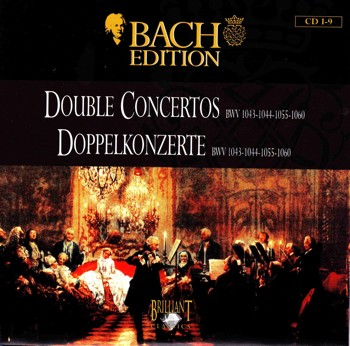 This CD, which contains Bach’s Double Concertos, features all of my favorite instruments (flute, violin, strings, and even harpsichord — played as a mood-setting accent) performing music that is truly remarkable. Not for its intricate or even frenzied contrapuntal complexities, but for its, well, pleasing-to-the-ear qualities. Bach’s Double Concertos (concertos for two solo instruments) are deceptively simple.
This CD, which contains Bach’s Double Concertos, features all of my favorite instruments (flute, violin, strings, and even harpsichord — played as a mood-setting accent) performing music that is truly remarkable. Not for its intricate or even frenzied contrapuntal complexities, but for its, well, pleasing-to-the-ear qualities. Bach’s Double Concertos (concertos for two solo instruments) are deceptively simple.
What these Double Concertos remind me of is chamber music, the kind of music played at hoidy-toidy gatherings of people who pat brie on crackers and sip expensive Chardonnay from crystal glasses. It’s very, very soothing (yet stimulating — which is weird) music that serves both as background for social gatherings and main event concerts with audiences actively watching and listening. Granted, Chamber Music didn’t come to fruition during Bach’s time (Hayden, 1732-1809, is considered the composer who fully explored Chamber Music). But this type of music, composed by Bach and played by select instruments instead of full orchestras, was the precursor to what we know as Chamber Music today.
Here’s what today’s music looks and sounds like. This is Concerto for 2 violins in D minor (BWV 1043), as performed by the Bach Festival Orchestra of Philadelphia.
Pleasant stuff, eh?
Although I tend to prefer music of a more lively nature, Bach’s adagio movement in BWV 1044 (Concerto for flute, violin, strings in A minor) features a style of playing that always makes me smile for some reason: Pizzicato. Whenever violinist’s pluck their strings it reminds me of a Loony Tunes cartoon with some character sneaking up on another one. (The plucking is the tip-toeing sound.) Adagio, which means to be played slowly or at ease, is usually where my mind begins to wander. So the pizzicato technique keeps me actively listening.
Of the four pieces of music on this CD, I enjoyed Concerto for oboe, violin, and strings in D minor (BWV 1060) best. I like the sound of the oboe. It soothes me and intrigues me at the same time. Both allegro movements from BWV 1060 are stirring and fun. (Allegro means cheerful or lively, so that’s not surprising.)
Another really fun piece of music is the Allegro ma non tanto movement from Concerto for oboe d’amore, strings, and b.c. (BWV 1055).
I’ll probably pop in this CD for background while I write. I enjoy it that much.
The compositions on this CD are:
BWV 1043 – 1717 (Bach was 32)
BWV 1044 – 1730 (Bach was 45)
BWV 1055 – 1741 (Bach was 56)
BWV 1060 – 1735 (Bach was 50)

 You can call me Johann. But don't expect me to answer to that.
You can call me Johann. But don't expect me to answer to that.
No Comments so far ↓
There are no comments yet...Kick things off by filling out the form below.